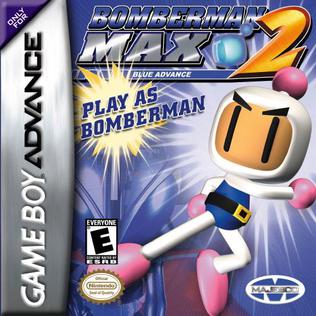 W
WBomberman Max 2 is a video game released for the Game Boy Advance on 30 May 2002 in North America. The game was preceded by Bomberman Max which was released for the Game Boy Color on May 14, 2000. As with Bomberman Max, there are two versions of Bomberman Max 2: Blue Advance and Red Advance. As in the first, in Blue Advance the playable character is Bomberman and in Red Advance the playable character is Max.
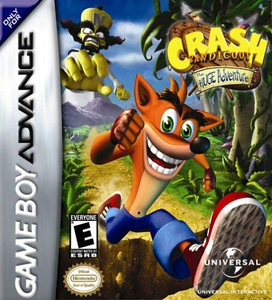 W
WCrash Bandicoot: The Huge Adventure is a platform game developed by Vicarious Visions and published by Universal Interactive for the Game Boy Advance. It was released in North America on February 25, 2002 and in Europe on March 15, 2002.
 W
WCroc: Legend of the Gobbos is a platform game developed by Argonaut Games and published by Fox Interactive. The game was an early example of a 3D platform game, being released in North America in September 1997 for the Sony PlayStation, and later on that year for the Sega Saturn and Microsoft Windows. Taking place in the fictional setting of the Gobbo Valley, Croc: Legend of the Gobbos follows a young crocodile named Croc, who sets out to rescue a group of furry creatures known as Gobbos from the evil magician Baron Dante.
 W
WDuke Nukem 3D is a first-person shooter video game developed by 3D Realms. It is a sequel to the platform games Duke Nukem and Duke Nukem II, published by 3D Realms.
 W
WDuke Nukem Forever is a first-person shooter video game developed by 3D Realms and published by 2K Games for Microsoft Windows, Mac OS X, PlayStation 3, and Xbox 360. It is the fifth installment in the Duke Nukem series and the sequel to 1996's Duke Nukem 3D. Duke Nukem Forever entered development in 1997 at 3D Realms and was finished by Triptych Games, Gearbox Software, and Piranha Games between 2009 and 2011. In the game, the player controls Duke Nukem, an action hero who must come out of retirement and save the world from aliens when they begin kidnapping the women of Earth.
 W
WFat Princess is an action real-time strategy video game developed by Titan Studios and published by Sony Computer Entertainment for the PlayStation 3. It was released in North America, Europe and Australia on July 30, 2009, and in Japan on December 25, 2009 as Pocchari Princess . It was included on the "Best of PlayStation Network Vol. 1" compilation disc, released on June 18, 2013. A PlayStation Portable version, titled Fat Princess: Fistful of Cake, was released in 2010.
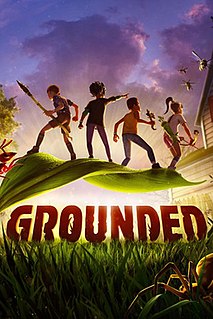 W
WGrounded is a survival game developed by Obsidian Entertainment and published by Xbox Game Studios. It was released for Windows and Xbox One in early access on July 28, 2020, with the full release expected in 2021. An enhanced version for the Xbox Series X/S was released on November 10, 2020. In the game, players are shrunk to the size of an ant and attempt to survive in a backyard filled with dangers.
 W
WHomeland is a role-playing video game for the Nintendo GameCube developed and published by Chunsoft, and was released in Japan on April 29, 2005.
 W
WKid Icarus: Uprising is a third-person shooter video game developed by Project Sora and Sora Ltd. and published by Nintendo for the Nintendo 3DS handheld video game console. Released worldwide in March 2012, it is the third installment in the Kid Icarus franchise; the first to be released since Kid Icarus: Of Myths and Monsters in 1991; and the first worldwide release since the original game in 1986. It is also the only video game to be made by Project Sora before it shut down in 2012.
 W
WKiller Instinct 2 is a fighting video game developed by Rare and manufactured by Midway for arcades in 1996 as a sequel to Killer Instinct (1994). A modified version of Killer Instinct 2, licensed by Nintendo, was published for the Nintendo 64 as Killer Instinct Gold that same year. A Super Nintendo Entertainment System version of Killer Instinct 2 was developed and completed, but never released. A digital port of the game for Xbox One is bundled with the second season of Killer Instinct (2013) under the title Killer Instinct 2 Classic.
 W
WKirby & The Amazing Mirror is a Kirby platform video game released in 2004 for the Game Boy Advance. Unlike most Kirby games, King Dedede does not appear in this game.
 W
WThe Legend of Spyro: A New Beginning is the first game in The Legend of Spyro trilogy, a reboot of the Spyro the Dragon series. It was developed by Krome Studios and published by Vivendi Universal Games for the Game Boy Advance, GameCube, PlayStation 2 and Xbox. Amaze Entertainment developed the Nintendo DS version.
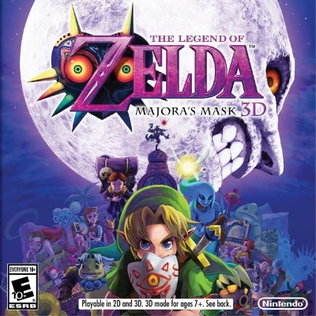 W
WThe Legend of Zelda: Majora's Mask 3D is an action-adventure game developed by Grezzo and published by Nintendo for the Nintendo 3DS handheld game console. The game is an enhanced remake of The Legend of Zelda: Majora's Mask, which was originally released for the Nintendo 64 home console in 2000. The game was released worldwide in February 2015, coinciding with the North American and European releases of the New Nintendo 3DS, to mostly positive reviews, with particular praise for its fluid gameplay, enhanced graphics and changes.
 W
WThe Legend of Zelda: Majora's Mask is an action-adventure game developed and published by Nintendo for the Nintendo 64. It was released in 2000 as the sixth main installment in The Legend of Zelda series and was the second to use 3D graphics, following 1998's The Legend of Zelda: Ocarina of Time, to which it is a direct sequel. Designed by a creative team led by Eiji Aonuma, Yoshiaki Koizumi, and Shigeru Miyamoto, Majora's Mask was completed in less than two years. It featured enhanced graphics and several gameplay changes from its predecessor, though it reused a number of elements and character models, which the game's creators called a creative decision made necessary by time constraints.
The Legend of Zelda: The Minish Cap is an action-adventure game and the twelfth entry in The Legend of Zelda series. Developed by Capcom and Flagship, with Nintendo overseeing the development process, it was released for the Game Boy Advance handheld game console in Japan and Europe in 2004 and in North America and Australia the following year. In June 2014, it was made available on the Wii U Virtual Console.
 W
WMario Party 3 is a party video game developed by Hudson Soft and published by Nintendo for the Nintendo 64. The third installment in the Mario Party series, it was first released in Japan on December 7, 2000, in North America on May 7, 2001, in Australia on September 3, 2001, and in Europe on November 16, 2001. As with the previous installments, the player chooses between eight playable characters: Mario, Luigi, Princess Peach, Yoshi, Wario, and Donkey Kong from the first two games, alongside newcomers Princess Daisy and Waluigi. The game features duel maps, where two players try to lower each other's stamina to zero using non-player characters such as Chain Chomps.
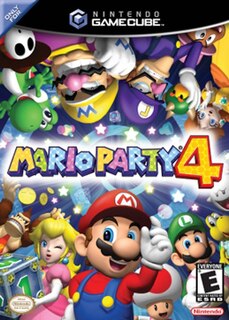 W
WMario Party 4 is a party video game developed by Hudson Soft and published by Nintendo for the GameCube. The fourth installment in the Mario Party series, it was first released in North America in October 2002, followed by Japan and Europe a month later. Like previous games in the series, it features eight playable characters: Mario, Luigi, Princess Peach, Yoshi, Wario, Donkey Kong, Princess Daisy, and Waluigi from the Mario series, who can be directed as characters on 6 themed game boards. The objective is to earn as many stars as possible, which are obtained by purchase from a single predefined space on the game board. Each character's movement is determined by a roll of a die, with a roll from each player forming a single turn. Each turn is followed by a minigame in which characters compete for coins they can use to purchase items and stars.
 W
WMario Party 10 is a party video game developed by NDcube and published by Nintendo for the Wii U. The tenth main installment in the Mario Party series, it was released worldwide in March 2015. It is the first game in the series since Mario Party 4 to have Donkey Kong as a playable character for every aspect of the game.
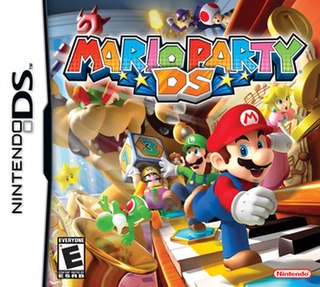 W
WMario Party DS is a 2007 party video game published by Nintendo for the Nintendo DS. It is the last Mario Party game to be developed by Hudson Soft, who was replaced on the franchise by Nd Cube in 2012. It was also released on the Virtual Console for the Wii U in April 2016. Mario Party DS was followed by Mario Party 9 for the Wii.
 W
WMicrocosm is a 3D rail shooter video game developed and published by Psygnosis in 1993. It was originally developed for the FM Towns, and also ported for the Sega Mega-CD, Amiga CD32, 3DO, and MS-DOS. Microcosm featured realistic FMV animation, with the graphics being rendered on Silicon Graphics workstations. The game is either in first person or third person view depending on the gaming system.
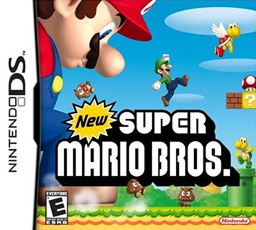 W
WNew Super Mario Bros. is a 2D side-scrolling platform video game in the New Super Mario Bros. series developed by Nintendo for their Nintendo DS handheld video game console. It was first released in May 2006 in North America and Japan, and in PAL regions the following month. It is a part of the New Super Mario Bros. subseries of the Super Mario franchise, and follows Mario as he fights his way through Bowser's henchmen to rescue Princess Peach. Mario has access to several power-ups that help him complete his quest, including the Super Mushroom, the Fire Flower, and the Starman, each giving him unique abilities. While traveling through eight worlds with a total of 80 levels, Mario must defeat Bowser Jr. and Bowser before saving Princess Peach.
 W
WNew Super Mario Bros. 2 is a 2D side-scrolling platform video game in the New Super Mario Bros. series developed by Nintendo for their Nintendo 3DS handheld video game console and was released on July 28, 2012. While being the third game in the series, it is a direct sequel to the 2006 Nintendo DS game New Super Mario Bros., a follow-up to the 2009 game New Super Mario Bros. Wii, and is the first Nintendo-published game to be released simultaneously in both digital and physical forms.
 W
WNew Super Mario Bros. Wii is a 2D side-scrolling platform video game developed by Nintendo for the Wii. A follow-up to the 2006 Nintendo DS game New Super Mario Bros., it was first released in Australia, North America, and Europe in November 2009, followed by Japan a month later. Like other side-scrolling Super Mario games, the player controls Mario as he travels eight worlds and fights Bowser's henchmen to rescue Princess Peach. Up to four people can play in cooperative and competitive multiplayer modes, taking control of Mario as well as Luigi and one of two multicolored Toads. The game also introduces "Super Guide", which allows the player to watch a computer-controlled character complete a level.
 W
WRatchet & Clank: Size Matters is a 2007 platformer video game developed by High Impact Games and published by Sony Computer Entertainment for the PlayStation Portable and PlayStation 2. The game is the first Ratchet & Clank title on the PlayStation Portable and the fifth Ratchet & Clank game for the PlayStation 2. Development company High Impact Games was spawned from the original Ratchet & Clank developer, Insomniac Games. The story is about Ratchet and Clank as they are interrupted from their vacation to search for a kidnapped girl and encounter a forgotten race known as the Technomites.
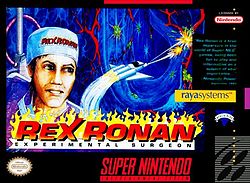 W
WRex Ronan: Experimental Surgeon is an educational action video game developed by Sculptured Software and published by Raya Systems for the Super Nintendo Entertainment System. The game teaches players about the hazards of smoking tobacco cigarettes. The initial development of the game received support from the US Agency for Healthcare Research and Quality. It is a part of educational video game series from Raya that includes Captain Novolin, Packy and Marlon and Bronkie the Bronchiasaurus.
 W
WSouth Park: The Stick of Truth is a 2014 role-playing video game developed by Obsidian Entertainment in collaboration with South Park Digital Studios and published by Ubisoft. Based on the American adult animated television series South Park, the game follows the New Kid, who has moved to the eponymous town and becomes involved in an epic role-play fantasy war involving humans, wizards, and elves, who are fighting for control of the all-powerful Stick of Truth. Their game quickly escalates out of control and brings them into conflict with aliens, Nazi zombies, and gnomes, threatening the entire town with destruction.
 W
WSuper Mario is a platform game series and media franchise created by Nintendo and featuring their mascot, Mario. Alternatively called the Super Mario Bros. series or simply the Mario series, it is the central series of the greater Mario franchise. At least one Super Mario game has been released for every major Nintendo video game console. There have also been a number of Super Mario video games released on non-Nintendo gaming platforms. How many Super Mario games there are has been debated. There are currently twenty-one similar games and one cross-series game that may or may not be included as part of the series.
 W
WSuper Mario Party is a party video game developed by NDcube and published by Nintendo for the Nintendo Switch. The eleventh main instalment in the Mario Party series, it was released worldwide on 5 October 2018, and sold 1.5 million copies by the end of the month, making it one of the system's best-selling titles. As of 30 September 2020, the game has sold 12.10 million copies.
 W
WSuper Monkey Ball 2 is a platform party video game developed by Amusement Vision and published by Sega in 2002 for the GameCube. It is the second installment in the Super Monkey Ball series, and the first installment to have a storyline and to be released on a home console.
 W
WSuper Monkey Ball Deluxe is a platform video game developed and published by Sega. It was released for the PlayStation 2 and Xbox in 2005. The game compiles all stages from Super Monkey Ball and Super Monkey Ball 2, as well as adding original levels. Super Monkey Ball Deluxe was well received, with critics praising the gameplay, but criticizing its audio and graphics. The game is also notable for its large number of customizable party mini-games, many of which are unique to Deluxe.
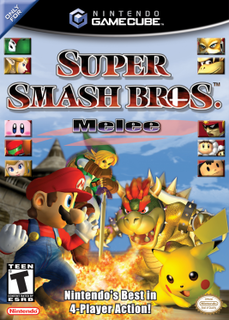 W
WSuper Smash Bros. Melee is a 2001 crossover fighting video game developed by HAL Laboratory and published by Nintendo for the GameCube. It is the second installment in the Super Smash Bros. series. It features characters from Nintendo video game franchises such as Mario, The Legend of Zelda, Star Fox, and Pokémon. The stages and gameplay modes reference or take designs from these franchises as well.
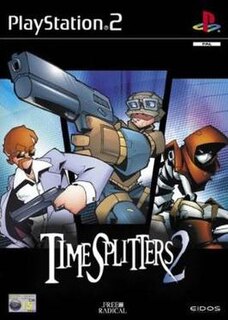 W
WTimeSplitters 2 is a first-person shooter video game developed by Free Radical Design and published by Eidos Interactive for PlayStation 2, GameCube and Xbox game consoles. It is the second game in the TimeSplitters series, and a sequel to the original TimeSplitters.
 W
WX Multiply is a side-scrolling shooter published by Irem, and similar in style to their earlier R-Type. In 1998, the game was released with Image Fight as a one-disc doublebill on PlayStation and Sega Saturn. In 2019, the game was released on the PlayStation 4 and Nintendo Switch as part of Hamster Corporation's Arcade Archives series.
 W
WYo-kai Watch 2: Bony Spirits and Yo-kai Watch 2: Fleshy Souls are a pair of role-playing video games developed and published by Level-5 for the Nintendo 3DS. The games are a sequel to 2013's Yo-kai Watch, and were released in July 2014 in Japan, and in North America and Australia in late 2016, and in Europe in 2017. Much like their predecessor, the games put players in an open world, befriending and battling various yōkai, which are ghosts and apparitions originating in Japanese folklore, that cause mischief in daily life. In Yo-kai Watch 2, the memories of the protagonists Nathan "Nate" Adams and Katie Forester are erased when their Yo-kai Watch is stolen, leaving them with no recollection of their past adventures. However, they soon stumble across their Yo-kai butler Whisper once again, and their adventures resume.